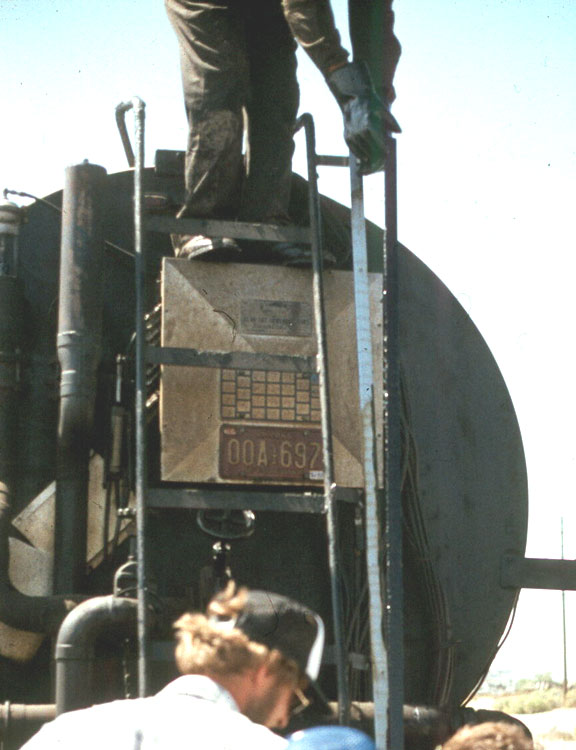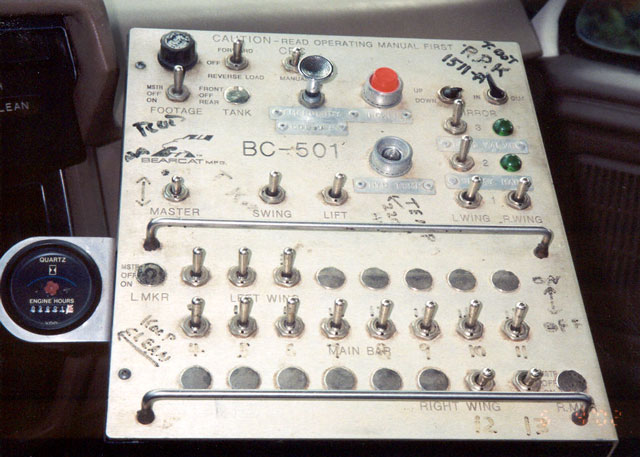Distributor Controls and Gauges
The asphalt distributor must deliver a uniform and precise amount of asphalt onto the roadway. Equally as important is the need for consistency throughout the length of the asphalt shot. Many gauges and controls are necessary to achieve this consistency.
Thermometer.
As mentioned earlier, a thermometer is used for monitoring asphalt temperature. Most are located in a well in the side of the tank. Some models have a dial thermometer mounted on the outside of the tank, with a thermocouple inside the tank. This type is more convenient to use and easier to read than the mercury thermometer, which must be removed from the well, but it is subject to malfunctions.Volume Gauge.
Most tanks are equipped with a volume gauge as shown in Figure 7‑24. These should be used only as a convenience to the operator to know when the tank is getting close to empty. They should never be used as the basis for payment.
Figure 7-24. Volume Gauge on Distributor Tank.
Strap Stick.
The manufacturer supplies a measuring stick (strap stick) with the distributor. Some distributors have the gallon levels on the stick itself. Others have a metal scale riveted on the side of the frame as seen in Figure 7‑25. The stick or scale must be in accordance with Test Method Tex-922-K, Part I. A discussion of how the distributor is “strapped” is provided in Chapter 8.
Figure 7-25. Strap Stick Used to Measure Quantity of Asphalt in Distributor Tank.
Pump Pressure or Rate.
All asphalt distributors have a power-driven pump to spray asphalt under pressure onto the roadway. The pumps also serve to provide a circulation system. Some distributors measure the pump pressure in pounds per square inch (psi) in the lines. This type of distributor is equipped with a conversion chart supplied by the manufacturer. The chart converts the amount of psi into gallons per minute (gpm) dispensed at the spray bar. Another type of distributor has the pump rate measured in gallons per minute increments. The gauge is a very important device, because the pressure under which asphalt is being sprayed will greatly influence the quality of the job. If the pressure is too low, the asphalt will streak and the pattern will be uneven. If the pressure is too high, the asphalt may atomize and the pattern may be distorted. The ill effects of this are magnified by high wind.The pump should be operated at the highest pressure possible without atomizing the asphalt. The way to determine the ideal pressure or pump rate is through field tests. Once the ideal pressure is determined from the test, the pump should be operated at that rate or pressure.
Most distributors are computerized so that the desired binder application rate is set by the distributor operator who then must operate the vehicle at a specific engine RPM.
Digital-Measuring Instrument (DMI).
Specifications require that a vehicle be furnished with a calibrated digital-measuring instrument, accurate to plus or minus 6 feet per mile. The inspector should verify that no modifications have been made that might affect the accuracy of the measuring instrument since calibration. Valve Control.
Another important control is the valve control which turns the spray on and off. A distributor operator must be able to turn all spray nozzles on and off simultaneously and instantaneously. This is a simple task in a computerized distributor and can be accomplished from inside the cab with a switch on the control panel as shown Figure 7‑26. At the beginning and end of a shot, the distributor passes over paper, which masks the pavement to form a straight, sharp line. The distributor must pass over the masking paper on both ends at spraying speed. The operator must be able to turn all nozzles on in the split second that the distributor passes over the masking paper.

Figure 7-26. Computerized Asphalt Distributor Controls.
A
computerized
distributor may be operated by one person, but a manually
operated distributor requires two people. On manually operated distributors, the driver lines up the machine and keeps it on line at the correct speed, while the spray operator works the valve control, and, on some models, sets the pump motor speed and monitors pump pressure. These two people must work as a team.